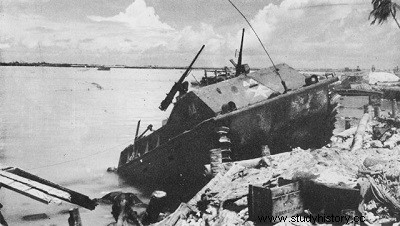
Once the jetty was neutralized, the assault waves began to s approach. Fire support, with the exception of a few ships that could follow the amtracks, was cut off. A few sporadic Japanese mortar fire then hit the barges and the artillery began to fire over the heads of the men. The machine guns soon added their fire and increased the confusion. Amphibious vehicles were disabled. But, by 9:10 a.m., a number of marines had jumped LVTs along the entire length of the beach; they had taken refuge behind a palisade of coconut tree trunks a little over a meter high. On the right, an enfilade fire from a Japanese strongpoint located in the "neck" brought down the amtracks towards the "beak" of the island. The losses were even heavier in this sector, but a second bridgehead - although one of the most cramped - had been conquered. It was then hell, in all its intensity.
All along the barrier reef, the LCVPs and LCMs were immobilized. The tide was too low to bring them to shore. This eventuality had moreover been foreseen:we knew that there was a fifty chance out of a hundred that the height of the water was insufficient. The fourth wave of marines began wading toward the beach. More waves followed, the men having water up to their chests. However, the Japanese, who had recovered from the preliminary bombardment, were concentrating their fire on the helpless men in the reefs. The marines were pinned down, in a storm of bursts and machine gun crossfire. On all sides men were collapsing in bloody foam; their happier comrades reached out to those who were still alive to drag them to the beach. only with excruciating slowness. It was very difficult for them to spot the Japanese, who were well concealed, except when they could see the flashes of departure, the orange-red tongues of fire spitting death in short bursts, springing from pillboxes and works on the ground. It was a question of demolishing these positions in the middle of which the men, as soon as they sketched a movement, found themselves placed in a new field of fire. It was an exhausting and deadly operation, carried out at the cost of incredible losses. The tanks eventually reached the shore and were able to take part in the fight, as soon as their drivers managed to make their way through the hallucinating pile of corpses floating on the lagoon.
Setting foot on shore along with the reserve units, Colonel Shoup, who was in command of the assault, reached Red Beach 2 before noon. Let's listen to him:“For fifty hours, I remained upright, almost all the time hidden behind a pillbox in which there were 26 Japs... quite alive! The situation facing Shoup was confusing to say the least. The transmissions were sporadic, the units disorganized, although still trying to progress; no one could have any idea what would happen next...hundreds of marines had already been killed or wounded and Shoup sent this message to Maryland:“Outcome uncertain. But the situation suddenly became clearer; another battalion was approaching, heavily attacked by Japanese dice fire, as it struggled to reach the beaches.
During the Arab rule in Palestine Christians had freely exercised their worship but when the region came under the control of the Turks churches were destroyed and pilgrimages were forbidden; this aroused much apprehension in Christian Europe where pilgrimages were essential for the manifestatio
